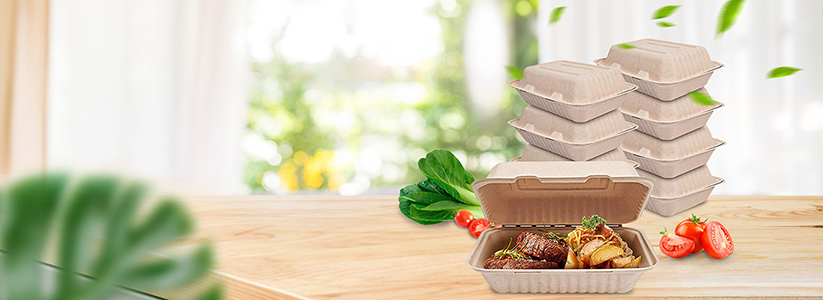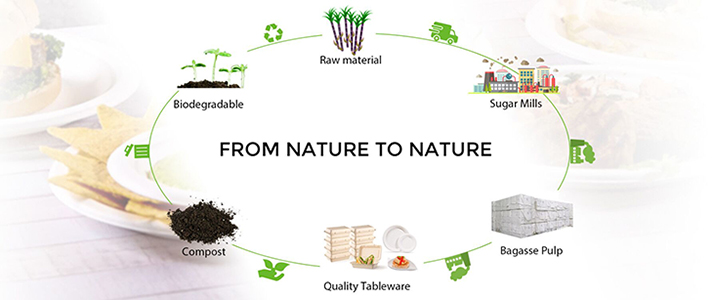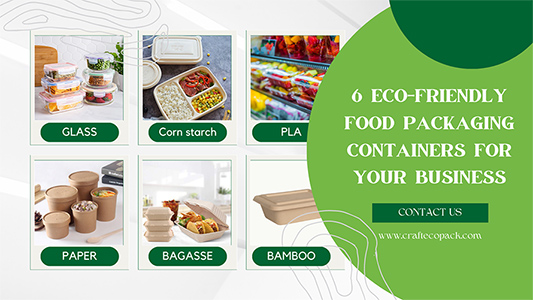Categories
New Blog
6 Eco-friendly Food Packaging Containers for Your Business
February 17 , 2023As the world becomes increasingly conscious of the environment, so too do businesses. Packaging for food production is vital as it reflects a company's commitment to green practices. With another beautiful year, companies must prioritize sustainability. However, fashion, homeware, sportswear, and other luxury brands may find it difficult to alter their packaging to be more eco-friendly. In this blog, we will share ideas to inspire you to make a change.
Let us understand the challenges of creating sustainable packaging with various materials instead of blindly sticking with anyone. Moreover, we will see how to replace plastic with one of the alternative 6 eco-friendly food packaging containers as we learn their benefits and downsides ahead.

Eco-Friendly Food Packaging: The Need for a Sustainable Switch
With the world's population growing, so too is the demand for food packaging that is not just efficient but also eco-friendly. The use of plastic packaging has become a significant environmental concern due to its non-biodegradable nature, and the world is now searching for alternatives that can be recycled, reused, or composted. Indeed, eco-friendly food packaging sounds like the perfect solution.
With a reduced amount of plastic waste generated, it will also reduce the amount of energy and natural resources used in production. Therefore, it has a good impact on the environment, proves pocket-friendly, and has less waste in landfills.
Moreover, with the increasing demand for eco-friendly food packaging, companies are now investing in developing new technologies, materials, and processes that are both sustainable and cost-effective. We hope to see a bright future for eco-friendly food packaging with more research and development to revolutionize the food packaging industry.

Making the Right Choice Among Biodegradable, Compostable, And Recyclable
Have you heard that the words "biodegradable," "compostable," and "recyclable" are often thrown around interchangeably, but they actually have vastly different meanings? Biodegradable materials can break down naturally, with the aid of microorganisms, into organic matter. Compostable materials are even better as they not only break down but also provide nutrients to the soil as they do so.
On the other hand, recyclable materials can be processed and turned into new products without compromising their quality. Confusing these terms could lead to damaging environmental consequences, so it's essential to understand the difference between them and make informed choices about the products we use and how we dispose of them for a greener future.
Which Food Packaging Container Materials Should You Use?

With the growing concern over single-use plastic waste, choosing a suitable food packaging container has never been more critical. Not only does the material need to be strong enough to protect the food, but it should also be attractive enough to draw in customers.
However, with so many options on the market, it can be overwhelming to determine which material is the best for your needs. Each material has unique benefits and drawbacks, from reusable containers made of stainless steel and glass to biodegradable options like bamboo and bagasse food containers. But before you make your next purchase, consider each material's durability, safety, and sustainability.
A little research can go a long way in helping you find the perfect container to store your food, reduce waste, and protect the planet. Check these six materials and determine which will best suit your needs!
1. Glass Containers
Glass food containers are a popular choice for food packaging, as they are non-porous, meaning they do not absorb food odors or flavors and are highly resistant to cracking and breaking, making them one of the most reliable materials.
In addition, glass packaging is 100% recyclable and reusable, making it an excellent choice for environmentally-friendly packaging. However, glass is heavier than other materials, making it more expensive to transport and store, and it can be more challenging to package certain products.
Advantages
· Durable and transparent
· Free of toxins
· Reusable and recyclable
· Environmentally friendly
Disadvantages
· Heavy and fragile
· Expensive
2. Corn starch Containers
Corn starch containers are a relatively new type of food packaging material that is gaining popularity due to their eco-friendly properties. These containers are made from a combination of corn starch and polylactic acid (PLA), making them biodegradable, compostable, and non-toxic.
Furthermore, corn starch containers are also lightweight and resistant to moisture, making them an excellent choice for packaging wet foods. However, these containers are not as strong or as durable as other materials and may require more frequent replacement.
Advantages
· Biodegradable, compostable, and non-toxic
· Lightweight and resistant to moisture
· It can be used to package wet foods
Disadvantages
· Not suitable for high-temperature applications
· Susceptible to cracking and breakage
· More expensive than other packaging materials
3. PLA Containers
PLA food containers are made from biodegradable plastics derived from plants, namely polylactic acid (PLA), and are highly sustainable. They are also lightweight, biodegradable, and cost-effective, making them a great choice for eco-friendly food packaging. However, PLA containers are unsuitable for hot foods, as they may melt or leak chemicals into the food.
Advantages
· Lightweight & durable
· Free of toxins & biodegradable
· Transparent appearance similar to traditional plastic containers
Disadvantages
· May melt or leach chemicals into the food
· Shorter lifespan
· Need for specialized composting facilities
4. Paper Containers
Paper containers are a great way to package food in an eco-friendly manner. Paper containers are made from recycled paper and can be composted after use. Paper containers are solid and moisture-resistant, making them ideal for storing and transporting dry and wet foods.
Paper containers are great for takeout orders, as they can easily be stacked and transported. Additionally, they are lightweight, strong, and can be printed with your logo or branding. However, they may require more frequent replacement.
Advantages
· Lightweight and recyclable
· Strong and moisture-resistant
· Made from renewable resources
· Biodegradable and composability
Disadvantages
· Potential for leaks or breaks
· Shorter lifespan
· Tendency to absorb odors and flavors from stored food
5. Bagasse Containers
Bagasse food containers are a type of eco friendly food packaging made from the fibrous remains of sugarcane, making them a renewable and sustainable packaging option. Further, bagasse food containers are lightweight, strong, and moisture-resistant, making them an ideal choice for storing and transporting both dry and wet foods. However, bagasse containers are not as strong or durable as other materials and may require frequent replacement.
Advantages
· Lightweight, strong, and moisture-resistant
· Renewable, compostable, and biodegradable
· A by-product of sugarcane production
· Microwavable
Disadvantages
· Shorter lifespan compared to traditional plastic containers
· Sometimes, it loses strength on extreme temperatures.
6. Bamboo Containers
Bamboo is a sustainable material that is becoming increasingly popular for the fact that they are made from renewable resources. Bamboo food containers are lightweight, durable, and can be printed with your branding. Moreover, they are also heat-resistant and microwavable, making them ideal for hot foods. Bamboo containers are also environmentally friendly because they are compostable and recyclable.
Advantages
· Lightweight, strong, and moisture-resistant
· Renewable and composability
· Fast-growing and sustainable resource
· Heat-resistant and microwavable
Disadvantages
· Tendency to leak or break down in liquids
· Susceptible to breakage
Summary
Using eco-friendly food packaging containers, your business can show its commitment to green practices and reduce its environmental impact. From paper to biodegradable containers, there are various eco-friendly packaging options available for your food business.
Choosing the right food packaging container is personal and depends on your individual needs and values. Whether you're looking for durability, sustainability, or something in between, it's important to do your research and make an informed choice.